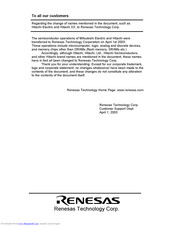Hitachi SH7751 Manuals
Manuals and User Guides for Hitachi SH7751. We have 1 Hitachi SH7751 manual available for free PDF download: Hardware Manual
Hitachi SH7751 Hardware Manual (1104 pages)
SuperH RISC engine
Table of Contents
-
Tables
41-
Figures
49
-
-
Data Formats74
-
-
-
Overview90
-
-
TLB Functions104
-
MMU Functions111
-
MMU Exceptions114
-
-
-
Section 4 Caches
126-
Overview126
-
-
Configuration130
-
Read Operation133
-
Write Operation134
-
RAM Mode136
-
OC Index Mode138
-
-
-
IC Address Array147
-
IC Data Array148
-
OC Address Array149
-
OC Data Array150
-
Store Queues152
-
-
-
Overview158
-
Exception Flow164
-
Usage Notes191
-
Restrictions192
-
-
-
Overview194
-
Data Formats194
-
Registers198
-
Rounding201
-
-
-
Addressing Modes208
-
Instruction Set212
-
-
Pipelines226
-
-
-
Overview254
-
Sleep Mode263
-
Deep Sleep Mode263
-
Pin Sleep Mode264
-
Standby Mode264
-
-
In Reset269
-
-
-
-
Overview280
-
Features280
-
-
Overview of CPG282
-
-
Using the WDT297
-
-
-
Overview302
-
Features302
-
Block Diagram303
-
-
-
(SH7751R Only)319
-
Operation320
-
Interrupts324
-
Usage Notes324
-
-
-
Overview326
-
Features326
-
Block Diagram327
-
-
Operation337
-
Interrupts341
-
Usage Notes342
-
-
-
Overview344
-
Features344
-
Block Diagram346
-
PCMCIA Support353
-
-
-
Operation398
-
Areas405
-
SRAM Interface409
-
DRAM Interface417
-
PCMCIA Interface461
-
MPX Interface472
-
-
-
Overview502
-
Operation522
-
Examples of Use558
-
-
Operation559
-
Pins in DDT Mode561
-
-
-
-
Usage Notes606
-
-
-
Overview608
-
Features608
-
Block Diagram610
-
-
-
Operation636
-
Overview636
-
-
Usage Notes667
-
-
-
Overview672
-
-
Operation702
-
Overview702
-
Serial Operation703
-
-
Usage Notes715
-
-
-
Overview718
-
Operation725
-
Overview725
-
Pin Connections726
-
Data Format727
-
Clock730
-
-
Usage Notes740
-
-
-
Overview746
-
Features746
-
Block Diagrams747
-
-
-
-
Overview768
-
-
INTC Operation786
-
-
-
Overview790
-
-
Operation802
-
Usage Notes809
-
Examples of Use812
-
-
-
Overview816
-
Operation837
-
Usage Notes839
-
-
-
Overview840
-
-
(Pciconf10)866
-
-
Operating Modes918
-
PCI Commands919
-
Host Functions921
-
PIO Transfers924
-
Target Transfers927
-
DMA Transfers930
-
-
Endians949
-
Resetting958
-
Interrupts959
-
Error Detection961
-
PCIC Clock961
-
Power Management962
-
Port Functions966
-
-
-
-
Bus Timing1003
-
Wait1045
-
Wait1046
-
-
Pin States1083
-
Advertisement
Advertisement
